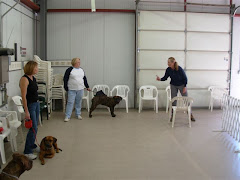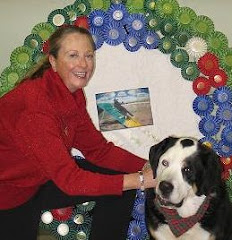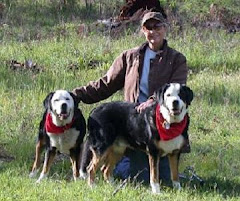Good leadership requires a PRO-active approach rather than just reactive. Good leadership prevents the dog from gong in the wrong direction in the first place. Ideally, leadership is established through daily living that impresses upon the dog's brain the fact that the human, not the dog, is the one in charge. However, not all dogs are equally receptive to this message, and not all humans are capable of convincing their dogs that they're up to the task of leading. Thus, the HEAD HALTER was developed.
Head halters give people this one-upsmanship on their dogs. They provide the human control of the dog's head, because the leash attaches to a ring at the bottom of the halter, just under the dog's chin (and IN FRONT of the brain). They work on the same principle as a horse halter. If you put a collar around the base of a horse's neck and attached a lead rope, you'd have virtually no control if he wanted to pull away from you. But with the lead rope attached to a halter ring under the horse's chin, you have leverage working in your favor. You can easily turn and even stop a 1200-pound horse with a light tug of the lead rope.
Certainly big dogs can seem like horses if they're unruly on leashes. But little dogs (and their owners) may benefit just as much from a head halter.
The most popular and well designed head halter is the "Gentle Leader." Its forerunner, the "Halti," has design flaws that make it much less effective. Recently a couple new manufacturers have come out with designs that are knock-offs of both. If you're in the market for a head halter, avoid the Haltis and knock-offs, and get a "Gentle Leader." It's tried and true, and it's by far the most widely accepted among professional dog trainers.
The candidates for a Gentle Leader:
- Handlers whose dogs require firmer or better leadership than the handlers are capable of giving them. Some handlers are simply too passive, unmotivated, or physically incapable of projecting calm yet assertive leadership to their dogs.
- Dogs who exhibit aggression that stems from a lack of self control. These are dogs who do try to be "good" while on traditional leashes and collars, but have a hard time controlling their reactivity. They constantly battle with the urge to lunge out at passing dogs or even people.
There is hope, in both cases, that the dogs and the people will learn to do their respective jobs better, and eventually not require Gentle Leaders. As a trainer, these are my goals:
- teach the people how to control and develop the dogs' minds, not just their heads and bodies.
- help the dog practice and develop the self control necessary to be a respectable member of our society.
Where to get a Gentle Leader
You can find them at virtually all pet stores and most feed stores. They'll be in the '"leash and collar" department. They'll range in price from about $14 to $20. They come in a variety of colors, in Small, Medium, Large and Extra-Large. If you want a full selection, go online to dog.com, PetEdge or any similar on-line pet store.Once you buy the right size, GO TO A TRAINER for instruction. Do NOT rely on the sales clerk at Petsmart or Petco to help you, as these people generally know precious little about products or training. Invest in a 30-minute session with the best independent trainer in your area. He or she can fit the Gentle Leader to your dog and can get you started using it properly. There's a short DVD that comes with the G.L., but it's always better to get hands-on help from an expert, particularly if your dog has a strong negative reaction to it.
Note the way the G.L. fits on the yellow Lab in the above photo. The strap going behind the ears is quite snug. This allows the nose strap to be fitted at a diagonal to the dog's mouth. A small plastic latch at the base of the nose strap allows you to lock it on at the proper length. Placement of the nose strap at this diagonal should insure that the dog can fully open his mouth at all times.
The first time you put it on your dog...
He's not going to like it. In fact, as the instructions will tell you, "the more he resists it, the more he is a candidate for it." These devices are for hard-headed dogs who protest other traditional forms of training. They don't want to surrender their dominance. They REALLY don't want to be powerless when they see another dog or something else that usually triggers an "episode of high anxiety." The typical reaction of a first-time wearer is to immediately lower his nose to the ground and start pawing at the nylon strap to get it off his face. As soon as he feels the tension of the leash, he will resist even more strongly. He may round his back and stiffen, with his head down close to the ground. You MUST pull up on the leash immediaely with sufficient force to get the dog's head up. Once it's up, release the extra tension on the leash so the dog can relax with his head in normal position. He will probably have several more episodes of strong and sometimes even violent resistance. He may curl into a ball and throw himself to the ground. You must still get the head up; if you pull sideways, gently, in the direction the dog is curled, he will get up fairly easily. Be sure to praise (and use treats) whenever the dog is standing, relaxed. Slowly and gently pull the leash from one side and then the other, turning your dog's head ever so slightly. This will let the dog know you have control of him, but that it won't hurt him a bit. Lure the dog to walk with you in his normal walking position (at your side, not out in front.) Remember that you are not hurting your dog in any way; he is simply reacting to his loss of control. The more controlling a dog tends to be, the more he will resist giving in to the Gentle Leader.
Keep the leash fairly short when you're using a G.L. DO NOT use the device with a retractable leash until your dog has been fully trained to accept it. If there's too much slack in your leash, the dog can move ahead of you, throw himself to the ground, try to paw the strap off his nose, and tangle himself in the leash. If your leash is held too short, however, you'll be putting unnecessary and uncomfortable strain on the dog's face. Aim for a leash that's just long enough to have the dog walk in heel position without actually pulling on the Gentle Leader itself.
Do NOT leave the G.L. on your dog, unattended. Chances are, he will destroy it in 90 seconds when you're not looking. (Yes, he can get it off if he really works at it). DO put the G.L. on your dog when he is calm....before you get him out of the car, the house, or wherever his excitement starts. If you wait until your dog is already in a heightened state of agitation, you'll have a hard time getting it on him.
Teach your dog to associate the G.L. with pleasant things...going for walks, getting treats, etc. Ideally, you'll have a dog who looks forward to seeing you get it out because it means good things are coming.
I've often told people that they can walk the worst-behaved dog on the planet into Petsmart on a Gentle Leader, and no one will even know they're difficult. With the Gentle Leader, you can hold the dog close and guard his motions, and he'll have virtually no opportunity to bolt away from you or even get boisterous. It even makes "sit" a lot easier to accomplish.
Do not confuse the Gentle Leader with a muzzle. The design of the G.L. allows your dog to eat, drink, bark, and even defend himself by biting if he has to. He'll just have much less inclination to initiate any of those undesirable behaviors when wearing it. Some dogs take a few minutes and others take a few days to adjust to this device. You are taking away the dog's power to do things you don't want him to do in the first place (pull against the leash, lunge, etc.) Don't give up! Don't take it off and stick it in a drawer because your dog doesn't seem to like it or tolerate it! The Gentle Leader will not hurt your dog and will, in fact, allow him to go many more places and experience more things with you than he otherwise could. Tolerance is part of what you'll be teaching him.





















2 comments:
Thank you again, Jan. Your dog wisdom reduces problems before they begin. So happy I read this prior to applying the Gentle Leader on the Twins and Uncle Baron.
What I am seeing is that there is an increase in trend of gentle leader to control tough dogs
Post a Comment